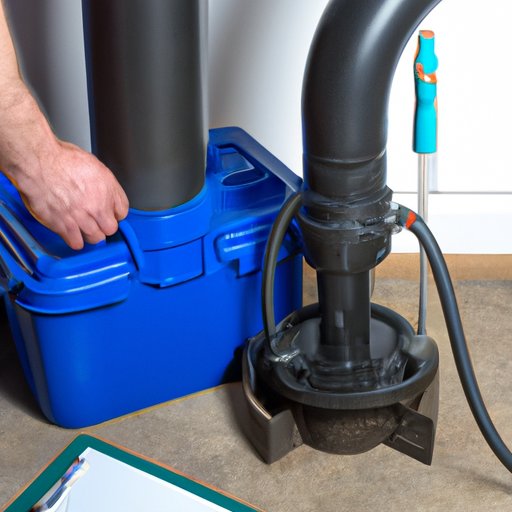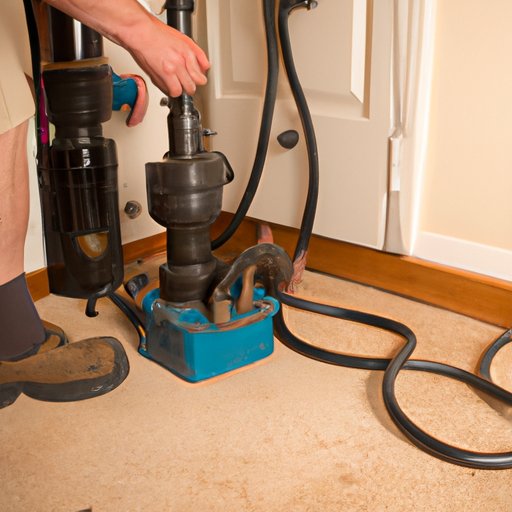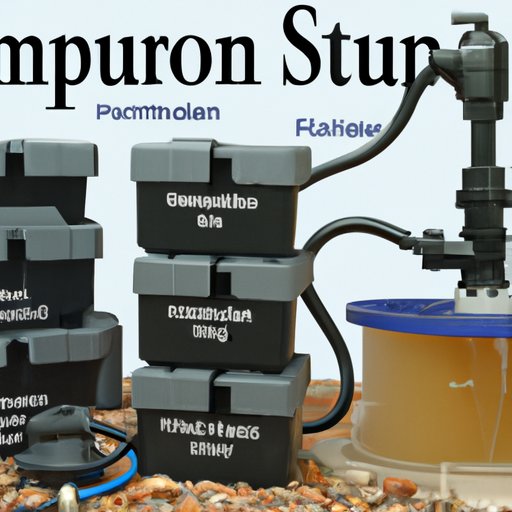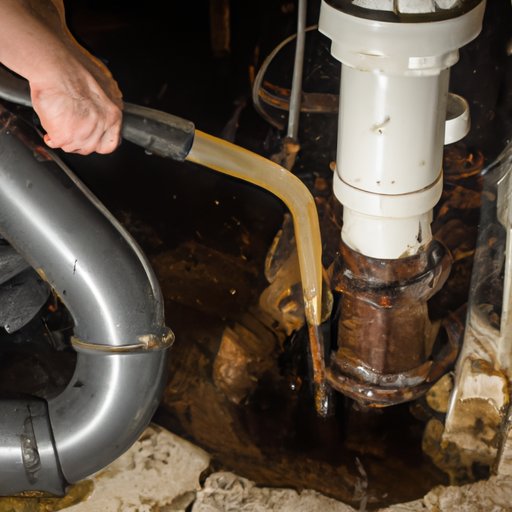Introduction
A sump pump is a device that is used to remove ground water from an area, such as a basement or crawlspace. It is typically installed in a sump pit, which is a shallow basin dug into the ground with a pipe leading to the outside of the building. The sump pump works by pumping the water out of the pit before it can reach damaging levels.
Groundwater can cause a wide range of problems in a home, including flooding, mold growth, and structural damage. A sump pump is an effective solution for preventing these problems, as it pumps the water out of the pit before it can reach damaging levels.
Exploring the Components and Function of a Sump Pump
A sump pump consists of several different components. These include the pump itself, a check valve, a float switch, and a discharge line. Each of these components has its own role in the functioning of the sump pump.
The pump is the most important component of the system, as it is responsible for actually moving the water out of the pit. The pump is powered either by electricity or a battery, depending on the type of sump pump being used. The check valve prevents the water from flowing back into the pit after it has been pumped out.
The float switch is attached to the pump and is triggered when the water level reaches a certain height. When this happens, the float switch triggers the pump to turn on and start pumping the water out. Finally, the discharge line is a pipe that leads from the pump to the outside of the building, allowing the water to be safely discharged away from the building.
Once all the components are in place, the sump pump is ready to go. When the water level in the pit begins to rise, the float switch triggers the pump to turn on, and the pump starts pumping the water out of the pit and through the discharge line. Once the water has been pumped out, the float switch turns off the pump and the cycle repeats.

How to Install and Maintain a Sump Pump for Homeowners
Installing a sump pump is a relatively straightforward process and can usually be done by a homeowner without any professional help. The first step is to dig a sump pit in the lowest area of the basement. The pit should be large enough to accommodate the sump pump and any other components. Once the pit is dug, the next step is to connect the pump to the power source and install the check valve and float switch.
Finally, the last step is to attach the discharge line to the pump and run it to the outside of the house. Once the installation is complete, it is important to test the pump to make sure it is working properly. Regular maintenance is also important in order to ensure the pump is running efficiently and effectively.
Regular maintenance includes checking the float switch and check valve, cleaning the pump and discharge line, and replacing the pump if necessary. Additionally, it is important to inspect the pump regularly for signs of wear and tear and to replace it if necessary.
Understanding the Different Types and Capabilities of Sump Pumps
There are two main types of sump pumps: submersible and pedestal. Submersible sump pumps are installed directly into the sump pit and are completely submerged in the water. They are more powerful than pedestal pumps, but they can be more difficult to access and repair.
Pedestal sump pumps are mounted above the sump pit and are not submerged in the water. They are less powerful than submersible pumps, but they are easier to access and repair. Additionally, some homeowners opt for a battery backup sump pump in case of a power outage.
The Benefits of Installing a Sump Pump in Your Basement
Having a sump pump in your basement can provide a number of benefits. First and foremost, it can protect against flooding and other water-related damage. If the water level in the sump pit rises too high, the pump will automatically turn on and pump the water out of the pit before it can reach damaging levels.
Additionally, a sump pump can prevent mold and mildew growth. If moisture is allowed to build up in the basement, it can create an ideal environment for mold and mildew growth. By removing the excess water, a sump pump can help to prevent this problem.

Troubleshooting Common Issues with Sump Pumps
Although sump pumps are generally reliable, there are a few common issues that can occur. One of the most common issues is a noisy pump. This is usually caused by air bubbles in the pump, which can be addressed by adding a vent hole to the discharge line. Other common issues include inadequate water removal and clogged lines.
Inadequate water removal can be caused by a weak pump or a clogged discharge line. If the pump is weak, it may need to be replaced. If the discharge line is clogged, it can be cleared by running a garden hose through it. Finally, a clogged line can be unclogged by using a plumber’s snake.

Tips for Choosing the Right Sump Pump for Your Home
When choosing a sump pump for your home, there are a few things to consider. First, think about the power source. Do you want to use an electric pump or a battery backup pump? Electric pumps are more powerful, but they require an electrical outlet nearby. Battery backup pumps are less powerful, but they don’t require an electrical outlet.
Next, consider the capacity of the pump. You’ll want to choose a pump with a capacity that is appropriate for your needs. Finally, understand the costs associated with installation and maintenance. Installing a sump pump can be expensive, so it’s important to factor this into your budget.
Conclusion
A sump pump is an effective solution for preventing flooding and other water-related damage in your basement. It consists of several different components, including the pump itself, a check valve, a float switch, and a discharge line. Installing and maintaining a sump pump is relatively straightforward and can usually be done by a homeowner without any professional help.
When choosing a sump pump for your home, consider the power source, capacity, and costs associated with installation and maintenance. Understanding how does a sump pump work and its capabilities can help you make an informed decision about which type of sump pump is best for your needs. Taking care of your sump pump and performing regular maintenance is essential for ensuring it runs efficiently and effectively.
(Note: Is this article not meeting your expectations? Do you have knowledge or insights to share? Unlock new opportunities and expand your reach by joining our authors team. Click Registration to join us and share your expertise with our readers.)
